The ‘DAU’ of Stalin Opens in Paris
Is the post-Soviet filmmaker behind a massive art-world happening an actual genius or an epic fraudster?
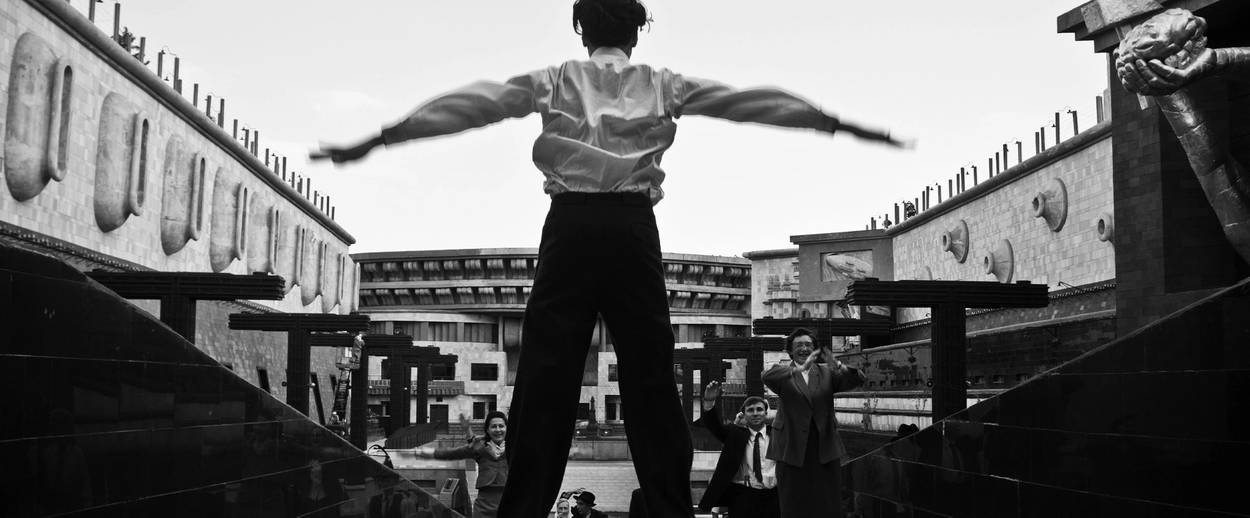
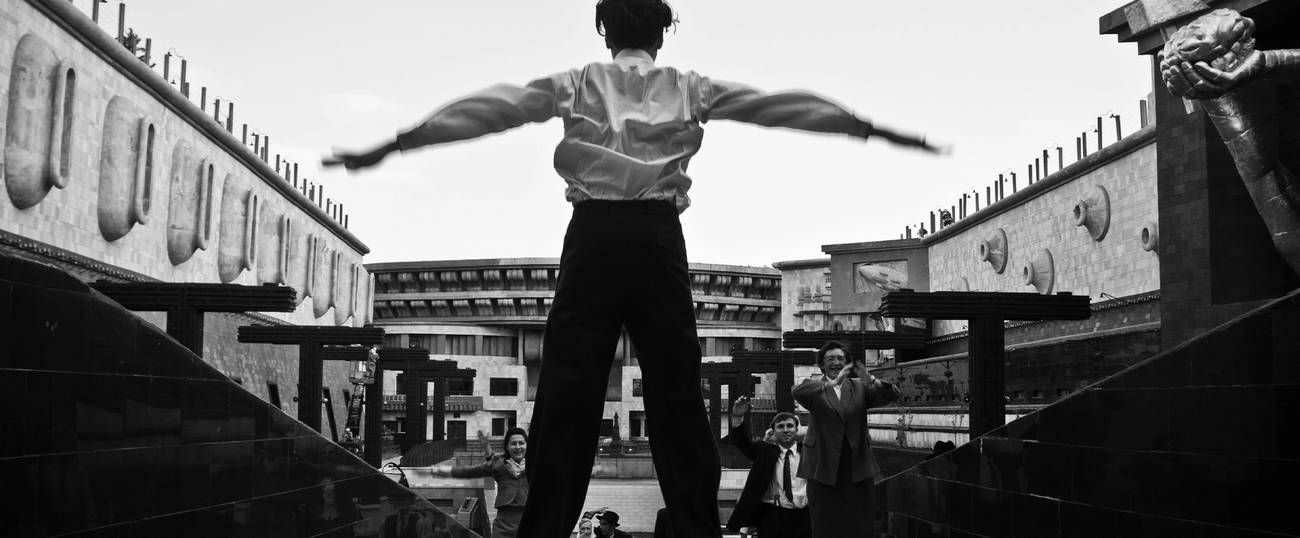


DAU, one of the longest-gestating film shoots in the history of cinema, is now over. By now you will have heard of Ilya Khrzhanovsky, an impossibly ambitious young Russian director who has been brewing up something tremendous. The project first began life a decade ago as a rather more conventional project—a biopic of the life of Lev Landau, the Baku-born Jewish physicist who had been awarded the 1962 Nobel Prize for his myriad and lasting contributions to almost every field of theoretical physics. Perhaps you have been following the film experiment from afar ever since you first read Michael Idov’s sensational dispatch from the Eastern Ukrainian city of Kharkiv where Landau had worked between 1932 and 1937. Since then, fueled by grandiose ambition and tremendous resources, the project had apparently morphed into something remarkable, inexplicable, and sinister.
You might have read the accounts of extravagant and eccentric goings-on in Kharkiv where a walled-off set was erected inside of an abandoned city pool and transformed into something insane. The sex and violence on screen would be unstaged, nothing would be planned and anything would be possible. You may have heard that much has been made of the obvious similarities between the allegedly licentious behavior of Khrzhanovsky and the free-love experimentation of the prize-winning scientist whose life he was determined to put on screen. The prominent Russian-Greek conductor Teodor Currentzis plays Landau, as Khrzhanovsky was said to be categorical in his decision that a “genius” would have to play the genius scientist. The role of the KGB officer who seizes control of the Institute from the scientists is played by real life KGB officer Vladimir Azhippo. A cast of thousands would be assembled and tens of thousands more interviewed for roles in the project. The postmodern novelist Vladimir Sorokin had worked on the original screenplay for the DAU biopic, when the project had been a film and had not yet morphed into a massive anthropological experiment on the meaning of human nature. Khrzhanovsky had made a single film before embarking upon DAU; his Four (2004) was a competently constructed work of surrealism (the plot included clones) likewise based on Sorokin’s vision.
You may know all about the cultish atmosphere and sexual shenanigans that took place during the filming. Or about Khrzhanovsky’s despotic and erratic antics on set, appropriately mirroring the despotism and erratic ruling style of the dictator who gave his name to the epoch. Maybe you are one of the numerous attractive young women who was sacked from the production after having declined Khrzhanovsky’s overtures. A prominent Ukrainian writer, actress, and cultural personality friend of mine rebuffed several offers to act in the film, on the condition that both her clothes and all rules would be removed. Half the Ukrainian film world has worked on the project, with most of them regretting having done so. You may have also read that in “the institute participants lived their fantasy lives with enough intensity for 14 children to have been conceived on set.”
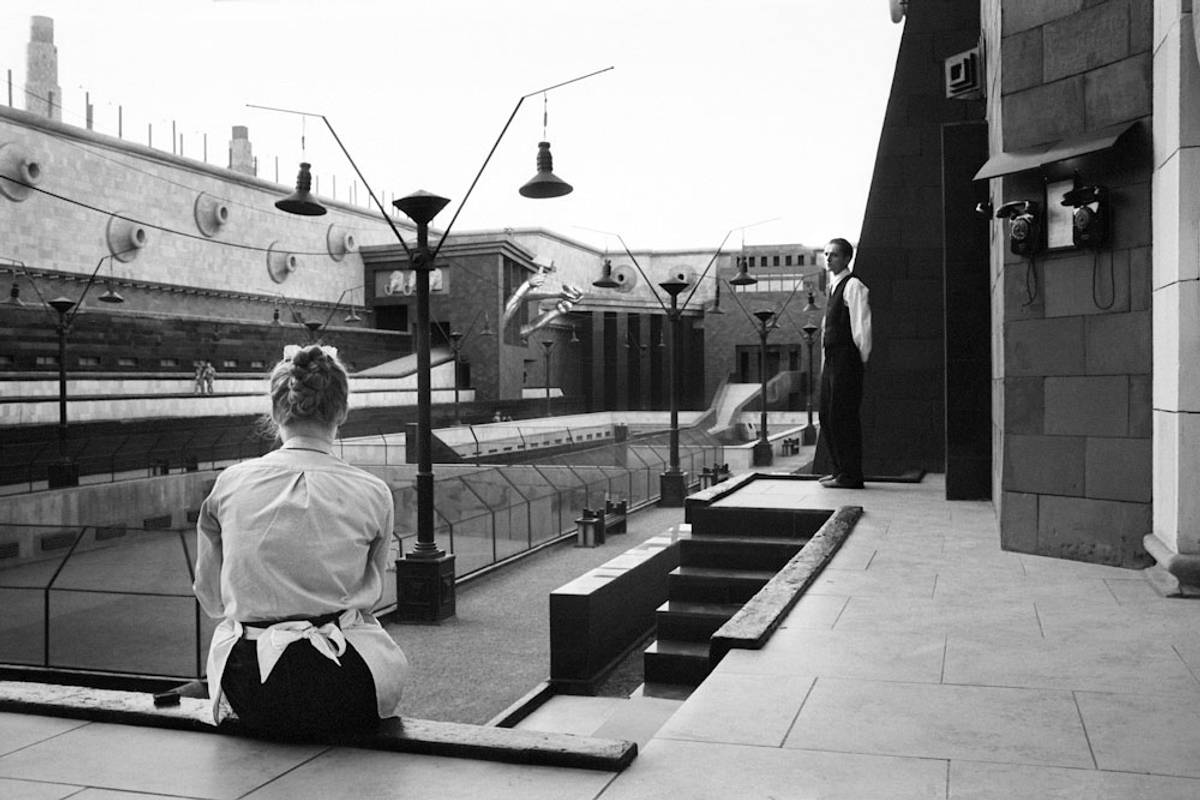
The sober details of Khrzhanovsky’s experiment, or folly, or descent into madness are no less bizarre. The director went about constructing a period Soviet institute where Soviet life would be enacted with total abandon and in perfect accuracy by participants wearing precisely recreated copies of Soviet clothing while living precisely recreated copies of Soviet lives. The institute—predictably also known as DAU—carried on after the filming was done as a self-sustained social experiment—a miniature city lost in time, complete with its own schools, cafés, dentists, opticians, and internal apparatus of repression—until Khrzhanovsky decided to conclude his experiment in living theater by arranging that it be ritually destroyed. The ruination was carried out by a gang of neo-Nazis (more on the neo-Nazis later) who had also taken part in the filming.
Like many people who have followed the evolution of the DAU project over the last decade, I had never really expected it to reach any sort of denouement. Even as people in my wider social circle spent months working furtively and in secret on something—something spectacular and grand, they would intimate, an unforgettable French premiere for the films—the premise that DAU would ever appear on Netflix seemed difficult to take seriously, even though the project has been lavishly funded by Sergey Adonyev, a Ukrainian-born Russian telecoms billionaire. Before Adonyev had come on board dozens of European, Russian, and Ukrainian foundations had funded the filming, becoming increasingly more irate as the evident lack of progress on the actual film stretched on for years and years.
Yet now DAU was upon us and Khrzhanovsky would be taking over both the Théâtre de Châtelet and the Théâtre de la Ville from the city of Paris for his production. Since their inauguration in 1862, Tchaikovsky, Debussy, Mahler, and Strauss have all conducted in the halls of the first theater, while Gounod, Bizet, and Berlioz have premiered historically important pieces in the other. Now they would be converted into a Stalinist-themed sex dungeon.
The inauguration of DAU was shambolic and botched, with many of the moving parts of the project unready for the public on opening night. This was partly because the city of Paris did not issue security permits in time. Instead of purchasing a ticket to visit DAU, which was open 24 hours a day, one was ushered through a purposefully cumbersome visa application process. During this interview, one was forced to divulge intimate information in a specially built glass booth situated in the Place du Châtelet, in between the two theaters.
The entry process was designed to be both expensive (entrance fees range from 35 to 150 euros depending on the amount of time one wants to spend in the kitsch communist dreamland), invasive, and massively uncomfortable, in true Soviet fashion. The registration booth was located under what would have been a temporary bridge connecting the two theaters, over which participants would have traversed without having to leave the late 1950s. Yet even the innate French reverence for eccentricity wrapped in high culture has its limits. The city of Paris flatly refused the demand to build a bridge connecting the two jewels of Haussmann’s Paris. Upon being informed of my references and credentials, and observing the Ukrainian flag pin in the lapel of my double-breasted overcoat (I naturally dressed in period style for the visit), the young Muscovite manning the “visa counter” fussed over me with an almost obsequious display of immaculate Russian courtesy.
The visa process was in any case not what it had originally been intended to be. Khrzhanovsky’s original intention, to reopen a replica Soviet embassy in the middle of the German capital, collapsed when the German authorities refused his demand to rebuild the Berlin Wall. The project never opened in Berlin, even as the production team had already paid for the printing of 20,000 reproductions of Soviet passports to be issued to participants. This had been done before the post-Maidan Ukrainian government had passed a wide-reaching package of decommunization laws in early 2015—thus making the printing of that sort of Soviet memorabilia criminal. The young Muscovite in the booth informed me that about two-thirds of the contraband passports had been smuggled out of Ukraine in clandestine fashion, but that the last shipment had been discovered and impounded by Ukrainian border guards.
Armed with our visas, we began our visit to DAU on the fourth floor of the Centre Pompidou, where a small gloomy chamber has been decorated to resemble a well-appointed Soviet apparatchik’s apartment. Standing motionless with his back turned to his visitors was an unkempt man dressed in soiled high-waisted slacks, rolled up shirtsleeves and a dramatically unfastened 1950s Soviet necktie. He had been living inside the museum—in this eerily perfect recreation of a physicist’s Soviet apartment—for the month-long duration of the project. Amusingly, the chamber was located around the corner from the Pompidou’s permanent collection display of photographs of Vito Acconci’s body performances. Unlike Acconci at the height of his early 1970s work with “Seedbed,” the physicist was not masturbating under the floor while yelling about his fantasies at his confounded viewers. But he might as well have been.
We knocked on the glass partition, and the unkempt man turned his gaze at myself, my wife, and our Ukrainian-Israeli friend through the glass. His skin was saturated with an unhealthy sallow tint and his gaze betrayed a paranoid concentration. The glint of lunacy was buttressed by boredom and curiosity. A native of Kharkiv, he claimed to have been a theoretical physicist during Soviet times. He held up a placard with slogans about teleportation scrawled on it. “The greatest achievement of the Kharkiv institute at Dau” he proceeded to tell us in an even monotone “was the invention of our wormhole-based teleportation device. The Americans are hoping to get access to it and to integrate it into their industrial military complex.” There was no way of telling if the scientist was executing a well-written script or if he was a run-of-the-mill madman. Or maybe there really is a wormhole-based teleportation device.
***
Half a mile away, at the entrance of the Théâtre de la Ville, one passed through airport-level security procedures and surrendered one’s cellular phone before being cast into a surreal eruption of the Soviet past into the present. The crowds mingled in a totally immersive replica Soviet world spliced with the foreboding atmospherics of Lynch and Cronenberg and Buñuel films. The adjectives “Kafkaesque” and “Lynchian” have been codified to describe the universalization of this aesthetic, but more than anything else the atmosphere was reminiscent of the films of the Czech surrealist Jan Švankmajer. The set of the DAU films inexorably recalls Matthew Barney’s Cremaster Cycle, another wondrous, mythologically overdrawn and flawed artistic production surrounded by years of noise, and irrevocably linked to the personal infamy of its charismatic progenitor. The rooms were cluttered with high-quality wooden 1950s furniture, paintings, and bric-a-brac. These were garlanded with Soviet tchotchkes, photographs, cutlery, pendants, Soviet board games and back issues of period-appropriate communist propaganda magazines. Eerie, life-size mannequin reproductions of the actors from the films were set up everywhere, and one kept confusing them with real people.
Young women from seemingly every post-Soviet republic walked around dressed in fetching period costumes. They engaged in otherworldly performances and exercises from theater workshop. Elements from the DAU set architecture had been retrofitted to decorate the interiors of the installations. The “museum shop” on the ground floor sold tins of Soviet packaged meats as well as “authentic” condoms in their “original” brown paper factory wrappers from 1959. One could only hope for the sake of buyers who might be tempted to use them that they were not as hopeless as the original Soviet variety.
The unalloyed chutzpah of it all: to have persuaded a pro-Putin oligarch to bankroll a brutalist private city-state art experiment and afterward to convince the doyens of the international art world to treat this prank as if it were the greatest art-world happening of the 21st century.
The tradition of ironically idolizing and nostalgically riffing off of the aesthetics of Soviet design and iconography while also skewering the malignancy of its ideals has a storied tradition. The entire installation is a life-size mock-up made by Ilya Kabakov of one of Viktor Pivovarov’s paintings. Completing this circle of influence, original Sots Art and Russian contemporary works from the Pompidou’s collection by artists such as Erik Bulatov, Grisha Bruskin, and Oscar Rabine were included in the decorations. Few commentators on DAU have focused on the project’s debt to the concerns and aesthetics of Moscow conceptualism. The lapidary return to Soviet realism of K’s films is ironic, but perhaps no one who reached any sort of age in the Soviet Union is totally immune to such influences.
Security guards were everywhere (some dressed as visitors, as I learned when I began rummaging through the kitchen cupboards and looking around for souvenirs to appropriate) and they intermingled with project actors and cast members until it became difficult to tell actors and spectators apart. One could not wholly escape the suspicion that the original Kharkiv installation had been the real project and one was now in the midst of a simulacrum of the original simulacrum. As it did in Kharkiv, the charismatic malignancy of Khrzhanovsky’s vision dragooned observers into becoming participants, with some French young people commencing to sit down in the Soviet kitchens and engage in banter while playing the board games.
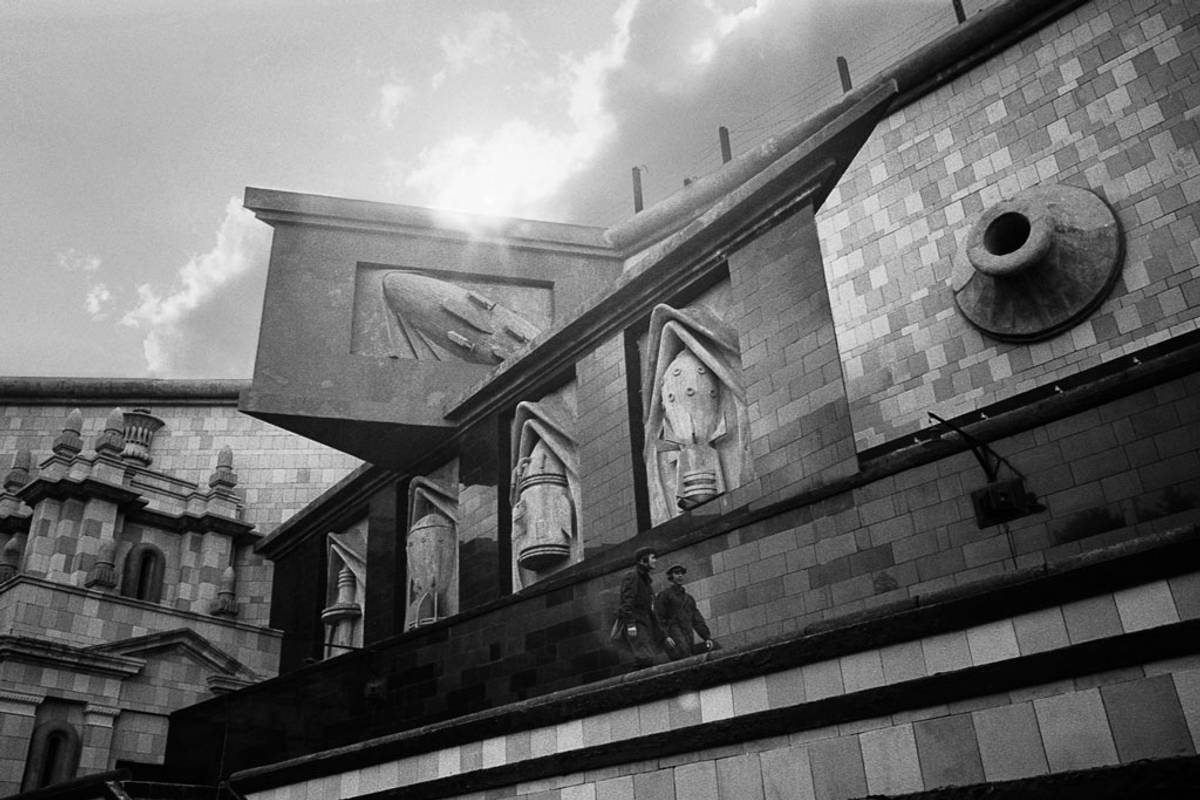
Along with my own friends, I promptly reverted to a state of primitive pre-post-Soviet self and began taking performative part in the spectacle. Wandering the halls, I spoke to Greek artists and German dance choreographers, and professional British mannequin makers who had been employed for years on the films. Still, the promised real-life shaman clerics, mathematicians, rabbis, and physicist were in short supply. Some French critics decried the takeover of the crown jewels of Parisian high culture by what they saw as a manifestation of a “Stalinist Disneyland.” Unimpressed, a prominent philosopher who attended the production drolly remarked to me, “I think it’s nice that Ilya and the boys are having so much fun with their art project.” Many found the bizarre replications of the Soviet apartment aesthetic to be disquieting. A prominent Russian painter in his mid fifties, who lives between Moscow and Paris, underlined his disgust with the whole project: “There should be an age limit of 35 for this hellish project, that is anyone who is older than 35 and who lived there, as I did, should not be allowed in. I lived through this! Why do I need to see this hell again?”
It’s fair to say that the first days of DAU were a disappointment. The botched rollout of the project was accompanied by numerous technical glitches, which created the spectacle of Russian luminaries arriving for the opening festivities only to shrilly complain of not being given their “entrance visa.” It took about a week of preparations for people to be able to see the films. After years of secretive planning—during which many of the young Russian speakers whom I know in Paris had been approached to work for miserly wages, and after French feminists had made a substantive push to get the whole thing canceled because of the numerous rape scenes in the films—the gargantuan ambitions of DAU floundered on banal manpower and organizational issues.
English and American critics seemed driven to distraction by the cacophonous theatricality and madness of it all, dutifully arriving in the early morning to report on DAU as if reporting to work at an infernal job in an industrial smelter somewhere in Eastern Ukraine, unable to grasp the totality and unbridled ambition of it all: exasperated by the chaos, unprofessionalism, and lack of coherence. But this was manifestly the wrong approach to take. My own, and that of my Ukrainian and Russian comrades, was to treat the happening as a sort of private vampiric nightclub. We would show up after dinner and linger until the next morning while drinking copiously and consuming narcotics and engaging in meandering existentialist conversations. What seems like half of Moscow also arrived in Paris to take part, from Russia’s decadent “golden youth” to journalist socialites like Ksenya Sobchak (who took to Russian social media to announce that Paris had been ruined since her previous visits), down to the art and architecture students on a budget. My apartment in the Marais, a 10-minute walk from the theaters, was transformed into a guest hostel, with more than half a dozen visiting Russian and Ukrainian acquaintances taking turns sleeping on my couch in rotating shifts.
The promised nighttime Brian Eno concert did not materialize the evening that I attended, but various French movie stars and starlets could be seen flitting about. Actor Gerard Depardieu—who remains banned from visiting the real-life Ukraine—seemed to possess a large participatory role, which remains somewhat inexplicable. Inexpensive and period-appropriate vodka and cognac were served in period-appropriate quantities in period-appropriate mead mugs at the Soviet canteen. Blessedly, one could bring the mead mugs into the auditorium for the duration of the films. How else could anyone sit through the two-hour-long unstaged lover’s quarrel and bouts of violent sexual coupling between a pair of mentally ill male street sweepers?
Before the screening of one DAU episode commenced, I had become engaged in conversation with a pair of contemporary art curators, ethereally beautiful Italian women in their late 20s along with their German artist companion. The sumptuously bearded and inscrutable German turned out to be Julius von Bismarck, a descendant of the Iron Chancellor who had a forthcoming exhibition in a major Paris art institution. As the screening began, the Italian woman seated next to me gracefully extracted a large packet of cocaine from her bra and began dicing it into lines with a credit card. She politely inquired if I desired to partake. On screen, the KGB officers began interrogating a portly Jewish scientist by calling him a “Zhid.”
In the basement of one of the theaters, futuristic silver screening booths—these obviously looked as if they had been brought in from a pornography shop—had been set up so that one could privately screen dozens of short clips from among the 700 hours of ancillary filmed material. On the top floor of the Théâtre de la Ville, our sneering prankster director host continued his debasing assault by opening up a bar decorated as a sex shop.
Most evenings, Khrzhanovsky could be seen there or else stalking the halls of the two theaters in his dark long overcoat, with dangling scarves with Byronic and undone white shirt cuffs peeking out from under the sleeves. His lips parted in a self-amused epicurean grin, with which he would issue lordly commands to his Russian and English speaking assistants. At the age of 43, the ample-figured Khrzhanovsky can no longer be properly referred to as a wunderkind, though he is certainly puckish. One has to admire him. The unrestrained libido and the unalloyed chutzpah of it all: to have persuaded a pro-Putin oligarch to bankroll a brutalist private city-state art experiment and afterward to convince the doyens of the international art world to treat this prank as if it were the greatest art-world happening of the 21st century. This certainly requires vision. Over the course of several evenings, I would run into him and his entourage drinking and eating their bland and period-authentic Soviet “Stolovka” cafeteria food (of the kind that is now bizarrely fashionable again in Kiev and Moscow). The black sturgeon caviar that Khrzhanovsky’s motley international of freaks and hangers-on licked off thick 1950s silverware was as exquisite as anything one could find this side of the Caspian. One night, thoroughly inebriated on cognac at about 5 in the morning, I tried to score Stalin-era narcotics off him.
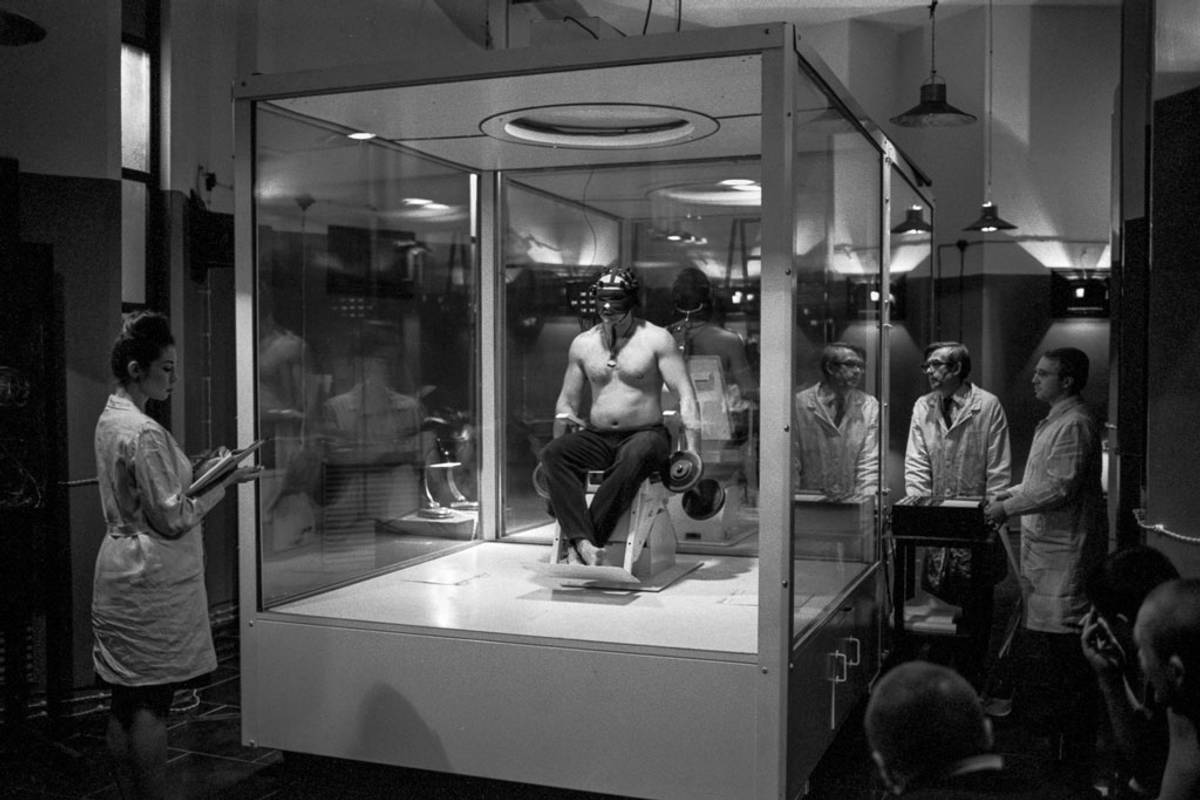
The character of the wrapping aside, DAU’s footage is incredibly varied in scope, alternating between gorgeous and affecting shots of the institute and montages of recreated Soviet everyday life, with the most brutal scenes of sex and violence. As the 13 (or was it 15?) films were played in a purposefully erratic order and without an announced schedule, grasping the totality of the material was almost impossible. No one I attended DAU with or spoke to seems to have seen all of the films, and certainly not in chronological order. We wound up relating the narratives of the parts that we had seen to one another in order to piece together the narrative. There are long, fascinating, and undulating scenes of life in the enclosed Soviet scientific city, and those aforementioned gruesome scenes of rape and molestation. There are several pitiless close-up instances of the butchering of animals. As the three decades of life in the institute pass, the communal kitchen in which much of the social life of the scientists plays out is slowly transformed from cleanliness to grim dilapidation.
Some of the films are crisply and professionally edited. Others are murkily lit and shot from odd vantage points and look as if they were hastily cobbled-together leftover material from the actual Dau epic, which has yet to materialize. The cavalier Landau comes on to the institute’s beautiful librarian. Later after she rebuffs him, he reacts with undisguised jealous rage as she is raped by another man. A tender 40-minute dialogue in Greek is left untranslated into any other language. Currentzis speaks Russian very softly and with a heavy Greek accent, rendering swathes of the protagonist’s dialogue almost incomprehensible. Amateur actors go about their “normal” days in the recreated Soviet dream world, with long shots of period-appropriate haircuts, and the ordering of food in cafés. If one is not a native Russian speaker, or at least familiar with and fascinated by Soviet history and imagery, much of the material can only be impenetrable.
The later plot of the film cycle has the KGB take over the institute from civilian control, with a simmering conflict ensuing between the security services and the scientists with their hedonic and free-spirited culture. The KGB view the scientists as decadent, and eventually bring in a group of real-life neo-Nazis to terrorize them—a process that leads to the liquidation of the institute. Ironically one of the most compelling characters standing out from hours of shambolic half acting by a cast of mostly amateurs is played by neo-Nazi leader Maxim Martsinkevich. (He is known in DAU and in “real life” as “Tesak”—the cleaver.) On screen, Tesak reenacted his real-life campaign of violence against Russian drug dealers by haranguing the scientists for their lack of austerity and drinking and smoking habits. The film also features the unscripted and actual beating by the neo-Nazis of an American artist who had taken part in the film. Tesak makes speeches to the scientists explaining that he is strong while they are weak. He mesmerizes and humiliates the scientists in the film with disquisitions on his experiences in the gulag. Having left the institute and returned to his life of assaulting drug dealers and Muslim migrants in Moscow, he is currently serving a 10-year sentence in a Russian penal colony for robbery, assault, and hooliganism.
In one of the basement theaters of the Théâtre du Châtelet, I caught the final episode of DAU (14-1), at a 2 a.m. screening on the penultimate night of the Paris run. The hallucinatory plot of the film that ties up the plot of all the others is based on disorderly flashbacks to the KBG man Azhippo discussing the usage of the narcotic ayahuasca with the director of the institute (played by the renowned Russian Mathematician Dimitry Kaledin). The KGB officer administers ayahuasca to the scientists in what is a combination scientific experiment and control operation and proceeds to arrest the waitress Natasha, who had been romantically involved with some of the scientists. There are close-up shots of the scientists reaction to the drug, and an interrogation scene where Azhippo coerces Natasha into drinking a bottle of cognac and using it to perform a gruesome act of sexual torture upon herself. The entire thing is told in a series of disordered shots and flashbacks and drug scenes, interspersing shots of the massacred scientists and the neo-Nazis destroying DAU. It all concludes with the night-long rave party that was organized on the ruins of the set.
As the film ended, the light returned to illuminate Kaledin sitting in the back and watching the final cut of the film for the first time along with one of the main actresses from the cycle. They were emotional, and the young woman was weeping, with her mascara blotched all over her face. It was all to easy to think that one was having a surreal experience in reaction to the surreal experience on the screen. At which point Kaledin turned to a lifelike mannequin of Landau seated in the back row of the theater and instructed it to “stop listening in to our conversation!” All of which is to say that the legends surrounding the characters, the production, and the context of DAU have all sadly turned out to be much more interesting than the actual films. Though to reiterate, it was functionally impossible to see them all.
***
For all its towering, overweening—perhaps mad—ambition, the project can only be understood through the context of Khrzhanovsky’s social milieu and as a manifestation of recent Russian history. A half century before his son created a phantasmagoric dreamworld recreation of Stalinism, Andrei Khrzhanovsky had been one of the most beloved animators of the Soviet Union. His 1968 masterpiece, The Glass Harmonica, depicted a fantastical dreamworld composed of hermetic imagery arrayed with formalist precision. It was a surrealist work of poetic tenderness. Despite being a seminal work of Soviet animation, it was swiftly banned for its portrayal of soul-dead bureaucrats awakened through the libidinous intercession of art. My own brief interactions over the years with the older Khrzhanovsky during his occasional Paris visits to deliver lectures have revealed him to be an exacting and amiable exemplar of an old-fashioned Soviet Jewish intelligentsia. Which is to say that he is a gent.
The symmetries and disparities between the works—and character—of the gentleman animator father and the reprobate filmmaker son are as striking as they are inexplicable. Andrei Khrzhanovsky’s Room and a Half, a 2009 animated biopic of the life of the Russian-American poet Joseph Brodsky, presented a saccharine worldview of gratingly wholesome Soviet romanticism. The film’s animations were charming and tender in the way that your Soviet grandfather is tender when stroking your hair while telling you about his experiences during the war, but the film’s own sentimentality for a bygone brew of traditional Russian, dissident, and Soviet culture was sickly and overwhelming—and in many ways the opposite of DAU’s pitiless impulses.
The younger Khrzhanovsky on the other hand is incontrovertibly a product of the volatile and tenebrous Moscow of the 1990s. He had grown up at the peak of the highest echelons of the Russian elite and the Moscow intelligentsia, and had known literally everyone in Russian intellectual and elite circles from his childhood onwards. Khrzhanovsky had just turned 15 when the Soviet Union dissolved and was in his mid-20s when President Vladimir Putin ascended to power. His film training took place in Moscow at the All-Russian State Institute of Cinematography (VGIK) in the late ’90s. As it had functioned through Soviet times, VGIK remains the most storied and elite film school operating in Russia. It has produced a large share of the major Soviet and Russian auteurs of the past decades and instills overwhelming ambition in even the least talented pupils. An omniscient sense of self along with grandiose delusions of being the next Sergei Parajanov, Kira Muratova, Nikita Mikhalkov, or Tarkovsky are inculcated along with one’s diploma.
While we have been promised that many more works (stand-alone films, a television series, vaguely defined forms of conceptual programming) remain to be released out of the 700 hours of footage shot in Kharkiv, it seems difficult to imagine a masterpiece being cobbled together from these disparate shards. There are those who are inclined to countenance DAU on the merits of its own self-appraisal as a timely allegory of the dehumanization of the individual by totalitarianism. That is a charitable view to take, but the films might very well have a shelf life and serve as a vehicle for Russians to do the hard work of grappling with the crimes of the suppressed Stalinist past. Or perhaps it was all merely the debased sadistic spectacle of a nice Jewish boy playing at being a Soviet tyrant, while succeeding only at being a debauched post-Soviet playboy? If so, that would at least proffer the project with the redemptive grace of serving as a parable of the ritual degeneration of the Russian intelligentsia.
Yet on second thought, it does seem that DAU represents the logical ripening of the influence of a certain dystopian stream of literature on contemporary Russian cinema. In that way DAU can be understood to be a final triumph of Sorokin’s bleak aesthetic and worldview. At the same moment that the Kremlin has cravenly doubled down on selectively mobilizing nostalgia for the Soviet past in building a nationalist future, this might be a veiled manner of dealing with the past.
The most beguiling and unresolved question lurking over the whole enterprise is whether Khrzhanovsky is an actual genius or an epic fraudster—or a fraudster elevated to the level of genius by a capacity to translate a very personal fantasia into reality. The installation project in the midst of Paris succeeded purely on the virtue of its brutalist grandiosity of scale and unhinged ambition. Born of infinite resources and expectations and hubris, the project’s formal artistic failure as cinema was as dialectically preordained as was the failed realization of the Soviet Communist utopia. Yet the Soviet-style command economy mobilization of resources needed to forge the institute in Kharkiv and the art installations in Paris succeeded.
Khrzhanovsky has built a testament to a great film that will never be—and could never be. DAU is a massive success as a feat of will, but a massive failure of artistry and craftsmanship. Still, Khrzhanovsky has certainly had immense fun in the process. I can’t wait for DAU to reopen in London in May. Comrades assemble: May this party never end!
Vladislav Davidzon is Tablet’s European culture correspondent and a Ukrainian-American writer, translator, and critic. He is the Chief Editor of The Odessa Review and a Non-Resident Fellow at the Atlantic Council. He was born in Tashkent, Uzbekistan, and lives in Paris.